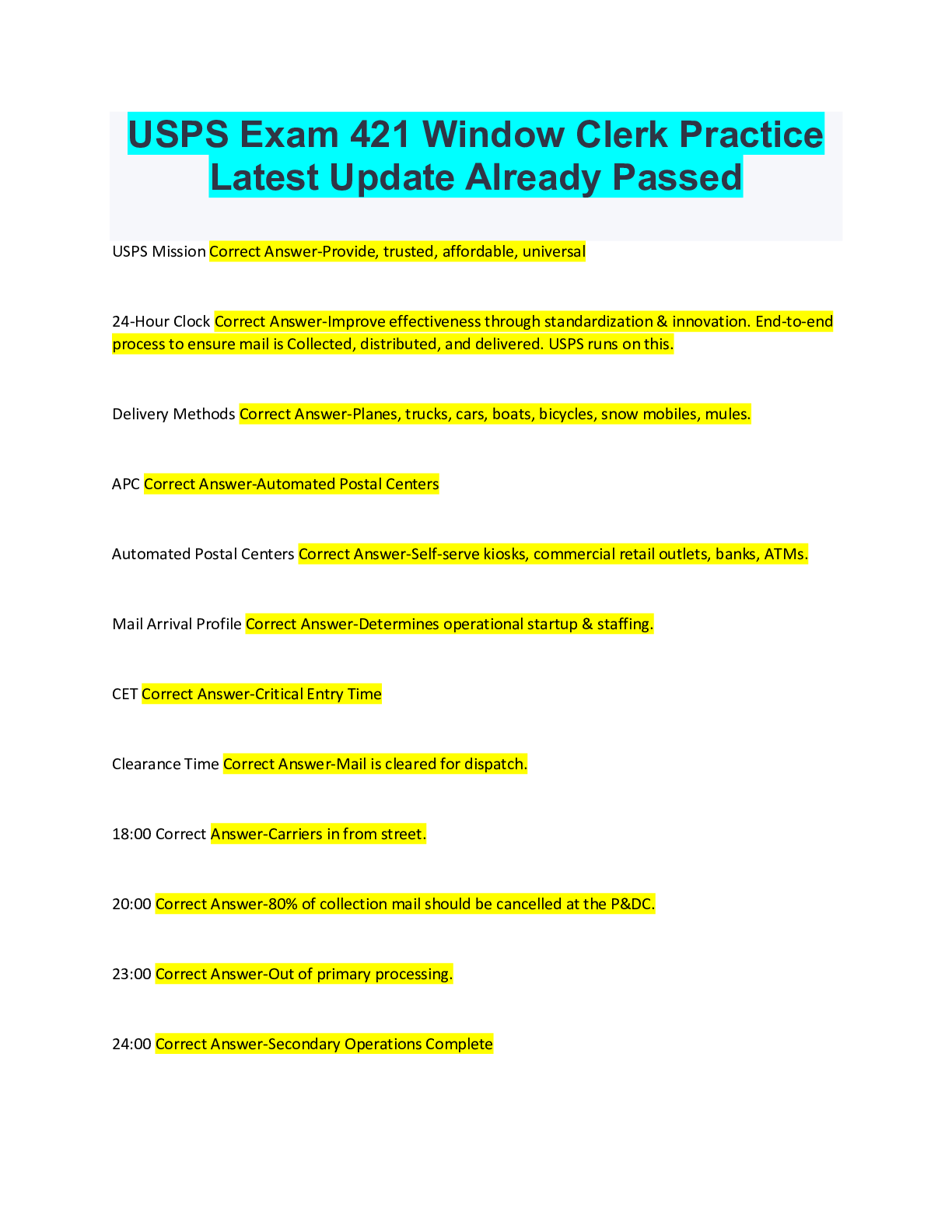*NURSING > QUESTIONS & ANSWERS > Ch. 30 Perioperative Nursing NCLEX Questions and answers with explanations. Rated A+ (All)
Ch. 30 Perioperative Nursing NCLEX Questions and answers with explanations. Rated A+
Document Content and Description Below
A perioperative nurse is preparing a patient for surgery for treatment of a ruptured spleen as the result of an automobile crash. The nurse knows that this type of surgery belongs in what category? a... . Minor, diagnostic b. Minor, elective c. Major, emergency d. Major, palliative - ☑☑-c. This surgery would involve a major body organ, has the potential for postoperative complications, requires hospitalization, and must be done immediately to save the patient's life. Elective surgery is a procedure that is preplanned by essentially healthy people. Diagnostic surgery is performed to confirm a diagnosis. Palliative surgery is not curative, rather it is done to relieve or reduce the intensity of an illness. A nurse is preparing a patient for a cesarean section and teaches her the effects of the regional anesthesia she will be receiving. Which effects would the nurse expect? Select all that apply. a. Loss of consciousness b. Relaxation of skeletal muscles c. Reduction or loss of reflex action d. Localized loss of sensation e. Prolonged pain relief after other anesthesia wears off f. Infiltrates the underlying tissues in an operative area - ☑☑-c, d. A localized loss of sensation and possible loss of reflexes occurs with a regional anesthetic. Loss of consciousness and relaxation of skeletal muscles occurs with general anesthesia. Prolonged pain relief after other anesthesia wears off and infiltration of the underlying tissues in an operative area occur with topical anesthesia. A nurse has been asked to witness a patient signature on an informed consent form for surgery. What information should be included on the form? Select all that apply. a) The option of nontreatment b) The underlying disease process and its natural course c) Notice that once the form is signed, the patient cannot withdraw consent d) Explanation of the guaranteed outcome of the procedure or treatment e) Name and qualifications of the provider of the procedure or treatment f) Explanation of the risks and benefits of the procedure or treatment - ☑☑-a, b, e, f A 72-year-old woman who is scheduled for a hip replacement is taking several medications on a regular basis. Which drug category might create a surgical risk for this patient? a. Anticoagulants b. Antacids c. Laxatives d. Sedatives - ☑☑-a. Anticoagulant drug therapy would increase the risk for hemorrhage during surgery. A nurse is caring for an obese patient who has had surgery. The nurse monitors this patient for what postoperative complication? a. Anesthetic agent interactions b. Impaired wound healing c. Hemorrhage d. Gas pains - ☑☑-b. Fatty tissue is less vascular and, therefore, less resistant to infection and more prone to delayed wound healing. A responsibility of the nurse is the administration of preoperative medications to patients. Which statements describe the action of these medications? Select all that apply. a. Diazepam is given to alleviate anxiety. b. Ranitidine is given to facilitate patient sedation. c. Atropine is given to decrease oral secretions. d. Morphine is given to depress respiratory function. e. Cimetidine is given to prevent laryngospasm. f. Fentanyl citrate-droperidol is given to facilitate a sense of calm. - ☑☑-a, c, f. Sedatives, such as diazepam (Valium), midazolam (Versed), or lorazepam (Ativan) are given to alleviate anxiety and decrease recall of events related to surgery. Anticholinergics, such as atropine and glycopyrrolate (Robinul) are given to decrease pulmonary and oral secretions and to prevent laryngospasm. Neuroleptanalgesic agents, such as fentanyl citrate-droperidol (Innovar) are given to cause a general state of calm and sleepiness. Histamine-2 receptor blockers, such as cimetidine (Tagamet) and ranitidine (Zantac) are given to decrease gastric acidity and volume. Narcotic analgesics, such as morphine, are given to facilitate patient sedation and relaxation and to decrease the amount [Show More]
Last updated: 1 year ago
Preview 1 out of 5 pages

Reviews( 0 )
Document information
Connected school, study & course
About the document
Uploaded On
Jun 28, 2022
Number of pages
5
Written in
Additional information
This document has been written for:
Uploaded
Jun 28, 2022
Downloads
0
Views
205

















.png)
.png)

.png)
.png)

.png)
.png)
.png)
.png)
.png)




.png)
.png)

